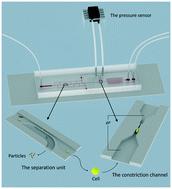Our official English website, www.x-mol.net, welcomes your
feedback! (Note: you will need to create a separate account there.)
Cell elasticity measurement using a microfluidic device with real-time pressure feedback.
Lab on a Chip ( IF 6.1 ) Pub Date : 2020-05-18 , DOI: 10.1039/d0lc00092b Zhenlin Chen 1 , Yonggang Zhu , Dong Xu , Md Mahbub Alam , Lingling Shui , Huaying Chen
Lab on a Chip ( IF 6.1 ) Pub Date : 2020-05-18 , DOI: 10.1039/d0lc00092b Zhenlin Chen 1 , Yonggang Zhu , Dong Xu , Md Mahbub Alam , Lingling Shui , Huaying Chen
Affiliation

|
The study of cell elasticity provides new insights into not only cell biology but also disease diagnosis based on cell mechanical state variation. Microfluidic technologies have made noticeable progress in studying cell deformation with capabilities of high throughput and automation. This paper reports the development of a novel microfluidic system to precisely measure the elasticity of cells having large deformation in a constriction channel. It integrated i) a separation unit to isolate rod- or flake-shaped particles that might block the constriction channel to increase the measurement throughput and ii) a pressure feedback system precisely detecting the pressure drop inducing the deformation of each cell. The fluid dynamics of the separation unit was modeled to understand the separation mechanism before the experimental determination of separation efficiency. Afterward, the pressure system was characterized to demonstrate its sensitivity and reproducibility in measuring the subtle pressure drop along a constriction channel. Finally, the microfluidic system was employed to study the stiffness of both K562 and endothelial cells. The cell protrusion and pressure drop were employed to calculate the mechanical properties based on a power-law rheology model describing the viscoelastic behaviors of cells. Both the stiffness and the fluidity of K562 and endothelial cells were consistent with those in previous studies. The system has remarkable application potential in the precise evaluation of cell mechanical properties.
中文翻译:

使用具有实时压力反馈的微流体设备进行细胞弹性测量。
细胞弹性的研究不仅提供了对细胞生物学的新见解,而且还为基于细胞力学状态变化的疾病诊断提供了新的见识。微流体技术在研究细胞变形方面取得了显着进展,具有高通量和自动化的能力。本文报道了一种新型的微流体系统的开发,该系统可精确地测量在收缩通道中具有大变形的细胞的弹性。它集成了:i)分离单元,以分离可能阻塞狭窄通道的棒状或片状颗粒,从而增加测量通量;和ii)压力反馈系统,可精确检测引起每个单元变形的压降。在对分离效率进行实验确定之前,对分离单元的流体动力学进行建模以了解分离机理。随后,对压力系统进行了表征,以证明其在测量沿收缩通道的细微压降时具有灵敏度和可重复性。最后,采用微流控系统研究K562和内皮细胞的硬度。基于描述细胞黏弹性行为的幂律流变模型,利用细胞突出和压降来计算机械性能。K562和内皮细胞的刚度和流动性与以前的研究一致。该系统在细胞力学性能的精确评估中具有巨大的应用潜力。压力系统的特征在于在测量沿收缩通道的细微压降时证明了其灵敏度和可重复性。最后,使用微流体系统研究K562和内皮细胞的硬度。基于描述细胞黏弹性行为的幂律流变模型,利用细胞突出和压降来计算机械性能。K562和内皮细胞的刚度和流动性与以前的研究一致。该系统在细胞力学性能的精确评估中具有巨大的应用潜力。压力系统的特征在于在测量沿收缩通道的细微压降时证明了其灵敏度和可重复性。最后,使用微流体系统研究K562和内皮细胞的硬度。基于描述细胞黏弹性行为的幂律流变模型,利用细胞突出和压降来计算机械性能。K562和内皮细胞的刚度和流动性与以前的研究一致。该系统在细胞力学性能的精确评估中具有巨大的应用潜力。微流系统用于研究K562和内皮细胞的硬度。基于描述细胞黏弹性行为的幂律流变模型,利用细胞突出和压降来计算机械性能。K562和内皮细胞的刚度和流动性与以前的研究一致。该系统在细胞力学性能的精确评估中具有巨大的应用潜力。微流系统用于研究K562和内皮细胞的硬度。基于描述细胞黏弹性行为的幂律流变模型,利用细胞突出和压降来计算机械性能。K562和内皮细胞的刚度和流动性与以前的研究一致。该系统在细胞力学性能的精确评估中具有巨大的应用潜力。
更新日期:2020-06-30
中文翻译:

使用具有实时压力反馈的微流体设备进行细胞弹性测量。
细胞弹性的研究不仅提供了对细胞生物学的新见解,而且还为基于细胞力学状态变化的疾病诊断提供了新的见识。微流体技术在研究细胞变形方面取得了显着进展,具有高通量和自动化的能力。本文报道了一种新型的微流体系统的开发,该系统可精确地测量在收缩通道中具有大变形的细胞的弹性。它集成了:i)分离单元,以分离可能阻塞狭窄通道的棒状或片状颗粒,从而增加测量通量;和ii)压力反馈系统,可精确检测引起每个单元变形的压降。在对分离效率进行实验确定之前,对分离单元的流体动力学进行建模以了解分离机理。随后,对压力系统进行了表征,以证明其在测量沿收缩通道的细微压降时具有灵敏度和可重复性。最后,采用微流控系统研究K562和内皮细胞的硬度。基于描述细胞黏弹性行为的幂律流变模型,利用细胞突出和压降来计算机械性能。K562和内皮细胞的刚度和流动性与以前的研究一致。该系统在细胞力学性能的精确评估中具有巨大的应用潜力。压力系统的特征在于在测量沿收缩通道的细微压降时证明了其灵敏度和可重复性。最后,使用微流体系统研究K562和内皮细胞的硬度。基于描述细胞黏弹性行为的幂律流变模型,利用细胞突出和压降来计算机械性能。K562和内皮细胞的刚度和流动性与以前的研究一致。该系统在细胞力学性能的精确评估中具有巨大的应用潜力。压力系统的特征在于在测量沿收缩通道的细微压降时证明了其灵敏度和可重复性。最后,使用微流体系统研究K562和内皮细胞的硬度。基于描述细胞黏弹性行为的幂律流变模型,利用细胞突出和压降来计算机械性能。K562和内皮细胞的刚度和流动性与以前的研究一致。该系统在细胞力学性能的精确评估中具有巨大的应用潜力。微流系统用于研究K562和内皮细胞的硬度。基于描述细胞黏弹性行为的幂律流变模型,利用细胞突出和压降来计算机械性能。K562和内皮细胞的刚度和流动性与以前的研究一致。该系统在细胞力学性能的精确评估中具有巨大的应用潜力。微流系统用于研究K562和内皮细胞的硬度。基于描述细胞黏弹性行为的幂律流变模型,利用细胞突出和压降来计算机械性能。K562和内皮细胞的刚度和流动性与以前的研究一致。该系统在细胞力学性能的精确评估中具有巨大的应用潜力。











































 京公网安备 11010802027423号
京公网安备 11010802027423号